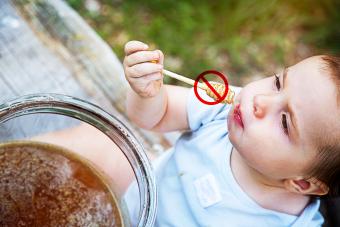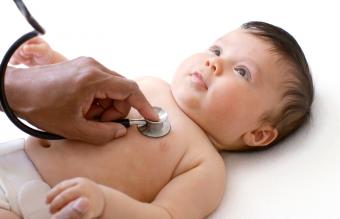
Jaundice in the newborn is a common occurrence of yellowing of the skin that, in most cases, is not serious and will go away on its own. However, severe cases can lead to brain damage in a baby called kernicterus if left untreated. New parents should know about the different types of jaundice and how this health concern is treated.
About Jaundice in Newborns
When pregnant, a mother's liver removes bilirubin, a waste product, from her fetus's liver. After birth, the baby's liver has to take over. Sometimes the liver is underdeveloped and cannot rid itself of the bilirubin.
When that is the case, jaundice occurs. About 60 percent of newborns have some jaundice, indicated by yellowing of their skin. It usually goes away within two weeks and without causing problems. Jaundice usually disappears on its own because the infant excretes bilirubin through the urine and feces. However, some cases of jaundice are severe and do require treatment.
Testing for Jaundice
Initial Testing
In the hospital jaundice is initially monitored via two types of noninvasive tests.
- TCB: A TCB, or transcutaneous bilirubin test, is a little light that is pressed gently on the infant's head. The device will read the practitioner a number to graph to determine how high the level of bilirubin is.
- TSB: If the TCB indicates a high level, blood will be drawn for a TSB, or total serum bilirubin. That level will determine the treatment level of the baby using a bilitool.
After the initial TCB and TSB test, some infants may need treatment and additional testing.
Additional Tests That May Be Needed
To determine the cause and type of jaundice, more testing may be ordered. These tests help clinicians know what to do next:
- Complete Blood Count (CBC) - A CBC will rule out infection for the newborn and also check the blood levels of the baby for dehydration.
- Direct Antiglobulin Test/Coomb's test - This test will tell if the red blood cells have sticky antibodies from the mother than may be destroying them
- Reticulocyte count - This test will pinpoint anemia, low red blood cells, and if there are red blood cells being destroyed. If the red blood cells are destroyed, the baby cannot fight off the bilirubin in his or her liver.
Types of Jaundice in Newborns
Physiologic Jaundice
Physiologic jaundice, which is considered harmless, is a jaundice that happens to many newborns. According to The University of Texas Medical Branch at Galveston (UTMB), physiologic jaundice "appears at about two days of age, peaks ... at three to four days and disappears by four to seven days." In low birth weight infants, the condition can last for up to 14 days, but still does not pose a health threat.
Jaundice Related to Breastfeeding
Jaundice may also sometimes occur in babies who are breast fed. There are two types:
- Breastfeeding jaundice- Some babies develop jaundice due to breastfeeding difficulties or because the mother's milk has not yet come in. The condition is not caused by a problem with the milk itself, but rather because the baby isn't getting enough milk. Consequently, the baby isn't eliminating enough waste to get rid of excess bilirubin.
- Breast milk jaundice- In other rare cases, breast milk is the problem, causing breast milk jaundice, in which case the mother should stop breastfeeding the baby, but she can pump her milk in order to maintain the supply. Once the jaundice clears up, normal breastfeeding can resume. This can appear in healthy babies who are breastfed, generally appearing after the first four to seven days of breastfeeding. This is different from breastfeeding jaundice because there is no lack of supply.
Pathologic Jaundice
Pathologic jaundice is more serious. It will not go away on its own and the baby will need treatment. According to UTMB, pathologic jaundice occurs within the first 24 hours of life and will generally persist for more than 10 days in a term infant.
If the newborn is noted to have pathologic jaundice, it is usually because of one, or more, of the following:
- ABO incompatibility: ABO incompatibility happens when a mother's blood type is different from her infant's, which can cause an excess of bilirubin in the blood.
- Inherited blood disorder: Diseases like Glucose-6-phosphate dehydrogenase deficiency (G6PD), hereditary spherocytosis, or a blood disorder such as thalassemia can cause pathologic jaundice.
- Traumatic delivery: During traumatic deliveries bleeding under the scalp called a cephalohematoma may develop, therefore making the newborn jaundice from the breakdown of the extravasated blood (blood that leaks into surrounding tissues).
- Delayed Meconium (the infant's first bowel movement): Delayed passage of meconium resulting from a bowel obstruction or slowed stomach movement may cause jaundice because the waste product (bilirubin) is not able to be passed.
-
Prematurity: Premature babies are at greater risk of developing jaundice due to their immature organs.
Prompt treatment is important to prevent brain damage to the infant.
Treatment for Jaundice
For the mildest cases, some doctors prescribe no treatment; the jaundice usually clears up on its own within a week or so. More frequent feedings may be prescribed at home. If your baby is jaundiced before 24 hours of life, it is important for treatment to begin promptly, because this is not normal.
Cases that are more serious may require the following treatments per Medscape.com:
- Light Therapy or Phototherapy: A newborn may be placed under special lights for phototherapy treatment. His eyes will be covered, and he'll only wear a diaper. The lights change the bilirubin molecules so that they're more easily broken down and expelled from the body. Sometimes, these lights are used in the form of a blanket as well. This does not hurt the baby at all, most babies sleep and are comfortable with the warm lights on them.
- Exchange Transfusion: This treatment is rare and is used when severe cases aren't helped by other methods. A newborn would receive small amounts of blood transfusions while small amounts of her blood are withdrawn, in order to dilute the bilirubin.
Going Home - Tips for Parents
Severe cases of jaundice will not only show up as yellow discoloration on the face, chest and legs, but will also appear on the palms of the hands and soles of the feet. Because many mothers and infants are discharged within a day or two of delivery, new parents should be vigilant to look out for signs of jaundice. Many pediatricians will want to see the infant within three days for follow up.
Besides yellowing of the skin, an infant may also display the following symptoms:
- Especially sleepy - While you may think it's a blessing, in reality it can be a real problem.
- Feeding difficulties - If the baby will not take as much food as he did in the hospital, this could be a sign of jaundice.
- Low diaper count - Remember, excreting waste in wet and dirty diapers helps clinicians know that the baby is doing well. The more the baby eats, the more bilirubin the baby will excrete.
Listen to Your Doctor
Your physician is the only one who can determine what type of jaundice your newborn has and if treatment is needed. If you notice any yellowing of your baby's skin, contact your pediatrician immediately.







